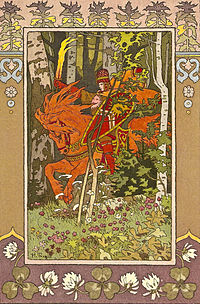Fairy tales and folktales get handed down, repurposed, and woven into new contexts and patterns every day. We see them in ads and single-panel cartoons, in similes, short stories, and novels. And yet when you ask Western people to tell you the story of, say, Little Red Riding Hood, they’ll probably come up with a lot of the same basic stuff. Some people wonder why stories so well known can continuously find new life; others bemoan the loss of variety folk traditions used to have before they became standardized by the Brothers Grimm and Disney.
But for writers, the fact that there’s a “standard” version of most popular fairy tales is a boon.
The Power of Foil Narratives
When you retell a fairy tale, or when you use a fairytale motif in a scene, chapter, or sentence, you draw on a shared cultural background with your reader. Whatever you say with your fairy tale contrasts with whatever they already know. Initially, that sounds a bit unappealing (if you retell “Beauty and the Beast,” your story gets thrown up next to a golden ball gown and a singing teapot, whether you like it or not). But it really is an immensely powerful tool.
You’ve heard of foil characters, yes? Two characters who share certain things and throw their differences into relief? Using foil characters is a good way to strengthen your characterization and drive interest. With fairy tales, you get an entire foil narrative. Even if your story or scene shares very little with an “original” fairy tale (original is such a messy word when speaking of folklore), if you have a character wearing a red hood, you can evoke an entire parallel plot line that can throw your narrative into relief. Each choice you make gains force and momentum because it contrasts with the story your reader already has in his or her head.
Stories That Rely on Foils
You can use fairy tales as foil narratives in all sorts of ways, and as I said before, you don’t have to write a story that is solely a retold fairy tale to do it. Permit me a few examples.
- Disney’s Enchanted is only really funny because viewers have a background in Disney fairy tales. Without them, the humor is much weaker.
- Ditto with Shrek, only it’s much funnier because it contrasts with an entire tradition of animal bridegroom stories (“Beauty and the Beast,” “The Frog Prince,” etc.).
- Roger Zelazny and Robert Sheckley embedded “Sleeping Beauty” into their novel Bring Me the Head of Prince Charming. The portion of the book that is a retold tale follows the standard exactly—prince fights his way through briars, kisses the sleeping princess into wakefulness, marries her, and resolves to live happily ever after—but the frame story of a demon playing puppet master lets the standard make a statement about free will.
Using Foils in Your Stories
You can employ a foil fairytale narrative by retelling a tale or merely evoking the idea of it—your reader already has the story in his or her head, so you don’t necessarily need to lay it out explicitly for them. Whether you’re embedding an abbreviated version of a tale in a scene or chapter, retelling the whole thing, or simply setting up a pleasant metaphor, you need give only the basic motifs because the standard fairy tale can do the rest of the work for you (you can give more, of course, but it isn’t necessary).
Some more examples.
- To evoke “Little Red Riding Hood” use motifs like a waiting wolf, a journey through the woods, a basket of goodies, a red hood, or an ugly grandmother.
- To evoke “Cinderella” use a glass slipper, a pumpkin coach, a stroke-of-midnight time limit, or a fairy godmother.
- To evoke “Jack and the Beanstalk” use magic beans, a giant in the sky, or a singing harp.
I’m sure you can come up with more motifs you could use to evoke a foil narrative in your writing, so share them in the comments. Also share your favorite retold tales, or even your favorite “original” versions (I’m partial to bloody animal bride/bridegroom stories, myself).




